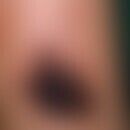Synonym(s)
dendritic grey-blue trabecula; Pseudotrabecula of melanophages; scattered grey-blue trabecular melanophages
DefinitionThis section has been translated automatically.
Interfollicular spaces filled with loosely aggregated melanophages In regions of high follicle density, they form so-called pseudo networks or secondary networks under reflected light microscopy. Follicular ostia correspond to the mesh centres. In regions with low follicle density or if a malignant process has destroyed the hair follicles, the trabeculae may appear diffusely distributed.
General informationThis section has been translated automatically.
Reflected light microscopy: The colour of the pseudo trabeculae appears brownish grey, slate grey, grey-violet or grey-black. In the spaces between the ostia tumor tissue can be replaced by loosely aggregated melanophages (so-called peppering phenomenon). Fine beam structures of coarse-grained melanophages sometimes determine the basic architecture of the reflected light microscope. In contrast to melanocytes, melanophages do not release melanin pigment into the environment.
You might also be interested in
OccurrenceThis section has been translated automatically.
Lentigo maligna, malignant melanomas and pigmented actinic keratoses show so-called melanophage pseudo-networks, especially in facial regions. Diffuse trabeculae of melanophagous clusters distributed over the lesion have a specificity of more than 80% for malignant melanomas. They are mainly found in regressive tumour areas.
HistologyThis section has been translated automatically.
Narrow atrophic epidermis with elapsed retelial ridges and severe flattening of the dermal papillae. Proliferation of atypical melanocytes in the basal cell layer and the dermo-epidermal junctional zone. The papillary stratum is interspersed with melanophagous agglomerates and inflammatory infiltrates.
LiteratureThis section has been translated automatically.
- Kazakov DV et al (2004) Melanoma with prominent pigment synthesis (animal-type melanoma): a case report with ultrastructural studies. At J Dermatopathol 26: 290-297
- Mannone F et al (2004) Dermoscopic features of mucosal melanosis. Dermatol Surge 30: 1118-1123
- Nakada K et al (2004) Ultrastructural characterization of the distribution of melanin and epidermal macrophages in photodamaged skin. Med Electron Microsc 37: 177-187
- Pellacani G et al (2004) In vivo confocal scanning laser microscopy of pigmented Spitz nevi: comparison of in vivo confocal images with dermoscopy and routine histopathology. J Am Acad Dermatol 51: 371-376
- Rhodes AR (1995) Commet on: "Malignant melanoma in epiluminescent microscopy". In: Sober AJ, Fitzpatrick TB (eds) Yearbook of Dermatology 1995, Mosby, St.Louis Baltimore Boston, pp 296-298
- Schulz C, Stucker M, Schulz H, Altmeyer P, Hoffmann K (1999) Correlation between epiluminescence microscopy characteristics of malignant melanomas and Clark's level of invasion. dermatologist 50: 785-790
- Schulz H (2002) Reflected light microscopic vital histology. Springer, Berlin Heidelberg New York






